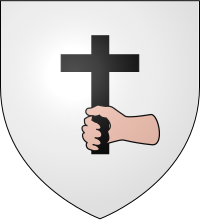

In heraldry, carnation is a tincture, the name for skin colour,[1][2] more exactly the colour of pale or European human skin[3] (i.e., pale pinkish orange).
It is rare in coats of arms in Anglophone countries but quite frequent on the European continent, in France in particular, derived from widespread use in German heraldry.[citation needed] In its rare appearances in Anglophone armory; it is not only used for European flesh tones, as in a crown rayonny or supported by two cubit arms, dexter carnation, sinister skeletal proper (crest of The Royal Australian and New Zealand College of Radiologists)[4] but is also used for a general pink colouring as in a horse passant argent bridled saddled and trappings or, on its head a plume of three feathers carnation (crest of The Worshipful Company of Saddlers, England).[5]
References
[edit]- ^ Friar, Stephen, ed. (1987). A New Dictionary of Heraldry. London: Alphabooks/A&C Black. p. 81. ISBN 0-906670-44-6.
- ^ Cadogan Rothery, Guy (1915) [1994]. Concise Encyclopedia of Heraldry. London: Senate, an imprint of Studio Editions Ltd. p. xvii. ISBN 1-85958-049-1.
- ^ Mike Oettle. "Colours of dye". Armoria. Archived from the original on 1 February 2014. Retrieved 30 January 2014.
- ^ "Coat of Arms: History and meaning of the College's Coat of Arms". The Royal Australian and New Zealand College of Radiologists. Retrieved 28 January 2014.
- ^ "Arms of the Saddlers Company". The Worshipful Company of Saddlers. Retrieved 28 January 2014. [dead link]
Well, that’s interesting to know that Psilotum nudum are known as whisk ferns. Psilotum nudum is the commoner species of the two. While the P. flaccidum is a rare species and is found in the tropical islands. Both the species are usually epiphytic in habit and grow upon tree ferns. These species may also be terrestrial and grow in humus or in the crevices of the rocks.
View the detailed Guide of Psilotum nudum: Detailed Study Of Psilotum Nudum (Whisk Fern), Classification, Anatomy, Reproduction